The Most
Reverend Colin D. Campbell DD
Bishop of Dunedin

Colin
Campbell was born in Otautau in 1941, he has spent most of his life
in and around Southland and Otago. He was
educated at St Therese's Convent School in North
Invercargill and at Marist Brothers' High
School. After study for the priesthood at Holy
Cross College, Mosgiel, he was ordained by
Bishop John Kavanagh in Dunedin in 1966.
He served in the
cathedral parish, and over the years in the
parishes of Mornington, Invercargill,
Georgetown, Bluff, Green Island and Waikiwi.
Furthering his studies, he completed a diploma
in religious education in London, a diploma in
liturgy in Germany and a bachelor of arts degree
at Massey.
He taught
pastoral theology at Mosgiel in the late 1980s,
and for some years was regional assistant in the
Dunedin Catholic Education Office. He has been a
hospital, school and port chaplain, and is
chaplain to the National Service Group of the
Catholic Charismatic Renewal and Dove
Fellowship.
He has found
great strength and support in belonging to a
prayer group and feels drawn to choose the words
"In the Spirit" as his motto.
In 2001 he was
appointed by the Holy See to be rector of Holy
Cross Seminary in Auckland.
"But I am
heartened to know that the Dunedin clergy have a
great esprit de corp among them - a good team
spirit. And we have a wonderful laity and
religious who are very dedicated and supportive
of pastoral initiatives," he said
Bishop Boyle and
the late Fr Leo Close have been significant
mentors in his journey of faith. "I realise that
I am following the steps of a wonderful pastor
in Bishop Len, who has always had a great sense
of openness, charity and hospitality towards
people. He is a man with a great pastoral heart
... it will be a hard act to follow!"
Using a
southerner image, Bishop Campbell likened
the discipleship of all God's people in the
community of the Church to gold miners, mining
for gold together, finding out the talents and
gifts of people, and how they can contribute
them in order to build up the kingdom of God.
"I would see the
ultimate goal as bishop to be that all may walk
'in all goodness and justice and truth'
(Ephesians 5.9), to quote from the Vatican
Council document on bishops." he said. "And I
would see a bishop as being like a Barnabas
figure. He is one of my favourites from the New
Testament.
"We read in Acts
that Barnabas was the man who went around
encouraging people. He was sent by the apostles
to do the rounds and check out how the
communities were going; to see who was needed,
when and where and how. The name Barnabas means
'Son of Encouragement'. It is my fervent hope
and prayer that I may follow his example."
Bishop Campbell was ordained bishop on July 9,
2004 after Bishop Boyle, whose resignation on
the ground of ill health
in 2002
was accepted by the Holy See.
The Coat of Arms
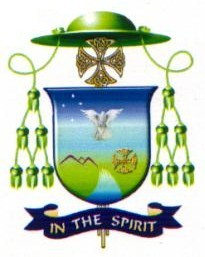
Bishop Campbell's Coat of Arms was designed for him by his
brother, Bryan Campbell.
The Shield bears the four stars of the Southern Cross, a
white dove, symbolic of the Holy Spirit; the mountains and hills of Otago and
Southland; the green fields of Southland's pastoral land; the Celtic Cross which
reflects both his own Scottish ancestry and the Scottish and the Irish origins
of so many of the Catholics in this diocese; and a river, which also has a
twofold symbolism: the rivers which are such dominant features of the Otago and
Southland landscape, and Christ's gift of his Spirit, which he described as
"streams of life-giving water" [John 7:37-39]. Under the shield is Bishop
Colin's chosen motto: "In the Spirit".
The Clerical hat and tassels are not part of the design,
but are required to accompany every bishop's coat of arms.
Go to top
1983 -1985
Co-Adjutor Bishop of
Dunedin
1985 -2004
Fifth Bishop of Dunedin
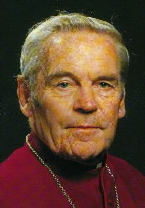
Leonard Boyle was born at Nightcaps, a
coal-mining town in Southland on November 16, 1930. His parents
owned hotels in Nightcaps and Winton. He was the sixth child to
be born among seven boys and two girls. All of Bishop Boyle's
grandparents were deceased when he was born and he always wanted
to find more about them. When he went to a place in Galway,
Ireland, called Anadown, he found his great grandfather's grave.
Bishop Boyle's great grandfather name
was Martin and his headstone had been erected by John Boyle of
New Zealand, who was Bishop Boyle's grandfather; so he traced his
links back to Ireland. A farm twelve miles out of Galway is owned
by the Boyles and nearby was a school which Martin Boyle went to.
Bishop Boyle's Irish heritage is very important to him.
For primary school, Bishop Boyle went
to the Sister of Mercy convents. Then he went to St Kevin's
College in Oamaru for four years. He left school for six years
and he went to the seminary, he had to go to St Kevin's and do
one year of studying Latin because a lot of books were in Latin
at the seminary.
Bishop Boyle decided to become a priest
at the age of about 22 or 23. Up until then he was farming and
shearing sheep in the Winton area. From the age of about six or
seven he wanted to be a farmer. As an adult he actually owned a
farm because he thought it was to be his life, but God had
something else in store for him.
Bishop Boyle had eight years training
to be a priest. After Seminary training at Mosgiel he was
ordained priest on July 31, 1961. From 1961 until 1983 Father Len
Boyle worked in various parishes in Otago and Southland including
Georgetown, South Dunedin and Invercargill. He was ordained
bishop on May 3, 1983. Two years later, on August 19 1985,
following the death of Bishop John Kavanagh, Bishop Boyle was installed as
Bishop of Dunedin. On May 24, 2004 Bishop Boyle has resigned after Father Campbell
was appointed Bishop of Dunedin by the Holy See.
Synod
Dunedin
OUR
DIOCESE

... OUR
JOURNEY
God
of light, guide us.
Ignite
in us a flame of Courage to stride ahead.
Challenge
us to tolerate differences.
Gift
us with wisdom to see we are not always right.
Enlighten
us to understand and action the needs of our community
Give
us strength to be faithful travellers on our journey
Go to top
The Most Reverend John Patrick Kavanagh DD JCD
1949 -1957
Apostolic Administrator and Co-Adjutor Bishop of
Dunedin
1957 -1985
Fourth Bishop of Dunedin

John Kavanagh was born in Hawera on 30 April
1913. In 1932 he began studying for the priesthood at Holy Cross
College,Mosgiel. He was ordained in Wellington on 6 September
1936, and then undertook postgraduate studies in Rome. He
returned to New Zealand with a Doctorate of Canon Law in November
1940, and served for four years as assistant priest in Lower Hutt
in the Diocese of Wellington.
Bishop Kavanagh had special links with the Polish
community in New Zealand. He was proud of his appointment as
legal guardian, with responsibility for settlement and welfare,
to 700 Polish children brought to New Zealand after the Second
World War. He was later honoured by the Polish Bishops'
Conference when they arranged for him to accompany Pope John Paul
II on his historic visit to Poland in 1979.
Dr Kavanagh was consecrated Coadjutor Bishop of
Dunedin in 1949, and appointed Apostolic Administrator with right
of succession. He exercised this right when Bishop Whyte died in
1957 after a long illness. As well as undertaking the
organisation and development of his diocese. Bishop Kavanagh made
an outstanding contribution to the life of the Church in New
Zealand. He took part in all four sessions of the Second Vatican
Council and had a deep grasp of where the Church was going. He
was a man of great intellect and was an avid reader, strongly
believing in the value of on-going formation and education for
himself and for others. He was instrumental in founding the New
Zealand Catholic Education Council in 1960, and served as its
Chairman for the next quarter century. As Chairman, he was
recognised as a key figure in the efforts to obtain State funding
for Catholic schools and, later, in the negotiations that led to
the passing of the Private Schools Conditional Integration Act.
Bishop Kavanagh was a member of the Council of
the University of Otago, the Bishop responsible for the national
seminary at Holy Cross College, Mosgiel, New Zealand, and also
served as President of the New Zealand Bishops' Conference.
He died on 10 July 1985. As Cardinal Williams
said at the time.
"His wisdom, his pastoral insights, his
encyclopaedia knowledge of law, his concerns to advance Catholic
education were all impressive facets of Bishop Kavanagh's
person."
Of your charity
Pray for the happy response of the soul of
John Patrick Kavanagh DD JCD
Born in Hawea, Taranaki, New Zealand, 30 April
1913
Ordained Priest, 6 September 1936
Administrator and Co-Adjutor Bishop of Dunedin with
right of succession, 30 November 1949.
Suceeded to the Diocese of Dunedin, as its 4th Bishop, 26
December 1957
Died Dunedin, 10 July 1985
Buried at Andersons Bay Cemetery
God our Father,
May your servant John Patrick Kavanagh who was our Bishop rejoice
in the followship of the successors of the apostles whose office
he shared in this life.
May he enjoy the reward of all his work and share the eternal joy
of his Lord.
We ask this through our Lord, Jesus Christ, your son who lives
and reigns with
you and the Holy Spirit, one God forever and ever. Amen.
Go to top
The Most
Reverend Hugh O'Neill DD JCD
1942-1949
Co-Adjutor Bishop of Dunedin

Milestones in the life of His
Lordship Bishop O'Neill
|
| Born at Dunedin |
June
29, 1898
|
| Baptised in St Joseph's
Cathedral, Dunedin |
July
17, 1898
|
| Entered Holy Cross
College, Mosgiel |
Febraury
14, 1914
|
| Ordained Priest, St
Joseph's Cathedral |
July
31, 1921
|
| Doctorate in Canon Law
(Rome) |
July
5, 1923
|
| Appointed Professor at
Holy Cross College, Mosgiel |
January
18, 1924
|
| Director of Propagation of
the Faith |
August
31, 1930
|
| Editor "Catholic
Missions" |
February
24, 1934
|
| Administrator of Parish of
Mosgiel |
June
22, 1934
|
| Chaplain to St Kevin's
College, Oamaru |
March
18, 1939
|
| NZ Secretary of the
Missionary Union of the Clergy |
August
17, 1939
|
| Appointed Titular Bishop
of Bareta and Coadjutor of Dunedin |
January
18, 1943
|
| Conscreated at Dunedin |
March
25, 1943
|
| Observed Sliver Jubliee of
Ordination |
August
8, 1946
|
| Resigned on Account of Ill
Health |
c
1947
|
| Led the National Holy Year
Piligrimage to Rome |
March
28, 1951
|
| Appointed a Vicar-General
of the Archdiocese of Wellington |
March,
1951
|
| Died at Dunedin |
December
27, 1955
|
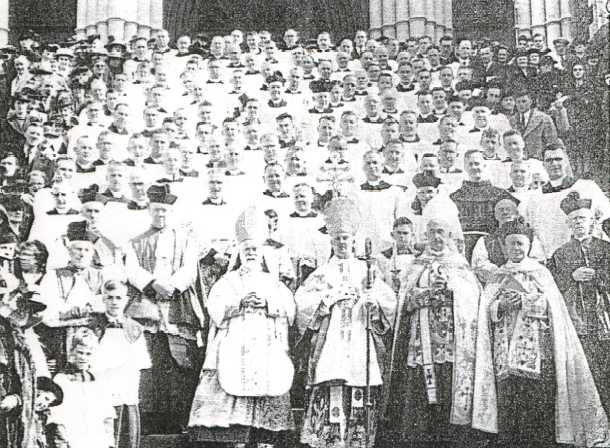
Bishop Hugh John O'Neill with
the consecrating prelates and clergy outside St Joseph's
Cathedral after his consecration on March 25, 1943.
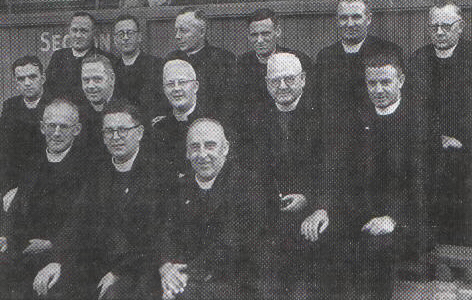
BISHOP
O'NEILL AND OLD BOY PRIESTS OF THE CHRISTIAN BROTHERS' HIGH
SCHOOL,
DUNEDIN, WHO WERE PRESENT AT THE JUBILEE CELEBRATIONS IN 1951.
Back row from left: Revs. K. Kean, V. Flaherty, G. Hussey, P.
McAleese, J. McCarthy, W. Quinn
Middle row from left: Revs P. Mee, C. Tylee, Bishop O'Neill,
Revs. W. Monaghan, F Columb.
Front row from left: Revs. E. Fahey, J. Pound and J. Halley.
Go to top
The Most
Reverend JamesWhyte DD
1920-1957
Third Bishop of Dunedin
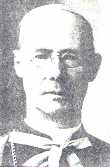
Dunedin's third Bishop was the Most Reverend James Whyte, DD. He
was born in Kilkenny City in Ireland in 1868. He studied for the priesthood at
St Kieran's College, Kilkenny, and was ordained on July 3, 1892. A few months
later he sailed to Australia to begin his priestly work in the Archdiocese of
Sydney, where his bishop was Patrick Francis Moran, former bishop of the Ossory
diocese in which Kilkenny is located.
His first appointment was a professorship at St
Patrick's College, Manly. The Rector of the college was Bishop
Verdon, who was Bishop Whyte's immediate predecessor of the See.
After some years at the seminary, he worked in various parishes
of the archdiocese. He was appointed Diocesan inspector of
Schools until his appointment at first parish priest of St
Michael's Stanmore. While at Stanmore, he was also Chancellor of
the Archdiocese.
On April 22, 1920, Bishop Whyte, who had been a
priest for 28 years, was appointed Bishop of Dunedin to fill the
vacancy, left by the death of Bishop Verdon in 1918.
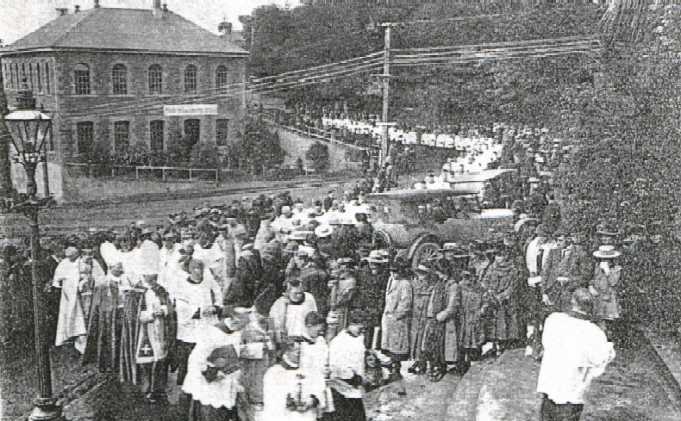
The Procession makes its way
into the Cathedral for the consecration ceremony of the two
Bishops, James Whyte and James Liston.
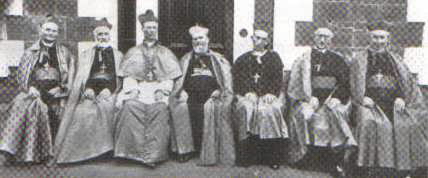
Prominent Catholic clergy in 1920,
gathered for Bishop Whyte's conscreation. From left Bishops
Cleary (Auckland); O'Shea; Whyte (the newly-appointed third
Bishop of Dunedin); Archbishop Redwood, who conscreated Bishop
Whyte; Bishop Liston; and Bishops Carroll (Lismore, NSW) and
Brodie (Christchurch).
Bishop Whyte was conscrated Bishop in St Joseph's
Cathedral on Sunday, December 12, 1920, together with Archbishop
Liston, who had been appointed Coadjutor Bishop of Auckland. This
conscreation ceremony was unique in the history of the Church in
New Zealand in that two priests had been raised to the
episcopate. The only regret was
. . ."there was not half room enough in St Joseph's for even
those who came from afar . . . ."
Under Bishop Whyte's direction, remarkable
progress was made in all parts of the diocese, and the building
or extension of churches, schools, convents, presbyteries and
charitable insitutions went on apace to keep abreast of the
growth of the diocese. Many buildings now stand as a tribute to
his work and enterprise.
In December 1941, Bishop Whyte suffered a stroke
and entered the Mater Hospital. For the next 16 years, he was
bedridden and unable to move about his diocese. These years were
years of patient suffering in a hospital bed.

Solemn Pontifical Requiem Mass was
offered in St Joseph's Cathedral for the Bishop who died in
Dunedin. The hierarchy of New Zealand who were present for the
ceremonies, are shown in the sanctuary of the cathedral.

THE FOUR CATHOLIC BISHOPS of New Zealand
(above) enter the Southern Cemetery for the burial of Bishop J.
Whyte. The Bishop of Christchurch, the Most Rev E. M. Joyce, is
shown at front, and he is followed by the Bishop of Auckland, the
Most Rev J. M. Liston; the Metropolitan of New Zealand,
Archbishop P. T. B. Mckeefry; and the Bishop of Dunedin, the Most
Rev J. P. Kavanagh.
Bishop Whyte died on December 26, 1957. At his
death, he had completed 89 years of age; 65 years as a priest and
37 years as a Bishop.
Bishop Whyte lies buried in the same Memorial as
the first Bishop Patrick Moran at the Southern Cemetery, Dunedin

MOST REV. JAMES WHYTE D.D.
Dunedin's third bishop, James Whyte, was born in
Kilkenny, Ireland in 1868. Ordained to the priesthood July 1892,
shortly after he sailed from Ireland to begin his priestly work
in the Archdiocese of Sydney. Professor at St Patrick's College,
Manly. Inspector of schools, parish priest of Stanmore.
Chancellor of the archdiocese. In 1920 he was appointed bishop of
Dunedin. His consecration as a bishop took place in St Joseph's
Cathedral, Dunedin, 12 December 1920. Under Bishop Whyte's
guidance, progress was made in the diocese he was a loving and
devoted Father in God.
Sixteen years bedridden. Bishop Whyte died 26
December 1957, 89 years of age, 65 years a priest, and 37 years a
bishop.
"He was a man of faith, and he lived by that
faith." May he rest in peace.
Go to top
The Most Reverend Michael Verdon DD
1896-1918
Second Bishop of Dunedin

The Most Rev Michael Verdon, an Irishman, a nephew of Cardinal Cullen of
Dublin and a cousin of Cardinal Moran of Sydney, was born in
1838, at Liverpool, the year Bishop Pompallier arrived in New
Zealand from France. As with Bishop Moran, he received his early
education from the Vincentian Fathers at Castleknock, and then to
the Irish College in Rome. After his ordination in 1861, he took
up parish work and was then appointed to Holy Cross Seminary at
Clonliffe, first as a teacher then as its rector. After eight
years on the staff of the Irish College in Rome, he was appointed
first Rector of St Patrick's College, Manly in Sydney. In 1896
when Michael Verdon was on his way to Rome to be the permanent
representative of the Australian Hierarchy, news of the Dunedin
appointment reached him at Melbourne.
Bishop Michael Verdon succeeded Bishop Moran in
1896, was the first Catholic Bishop to be consecrated in New
Zealand in 1896 by Cardinal Moran of Sydney. One of his first
concerns was the establishment of a national seminary in Dunedin,
with the support of the other bishops. Holy Cross College,
Mosgiel near Dunedin closed in 1997 with the relocation of the
new seminary in Auckland, was opened on the 3 May 1900, exactly
four years after Verdon's consecration. It was a significant step
forward for the Church in New Zealand, for the seminary has not
only ensured that there has been an adequate supply of clergy
trained for New Zealand conditions but has created a very real
bond between the secular priests of the country.
In the great influenza epidemic of 1918, which
caused the deaths of thousands of people throughout the country,
the Catholic schools became temporary hospitals and the nuns
became nurses. It was the first time that many of the patients
had come into direct contact with Catholic nuns and it did much
to break down the ignorance and prejudice about them that had
been widely current. Among the victims of the epidemic was the
Bishop of Dunedin, Dr Verdon, a man revered by his people both
for his scholarship and his holiness.
It is a measure of the man's inspiration that
Archbishop Liston of Auckland should also say of him:
"Little wonder then that ever since my coming to Auckland in
1920, I have kept his photograph on my working desk for happy
memories of the Bishop himself . . . for guidance through
reflection on his ways and for the seeking of his heavenly
intercession."
Bishop Verdon was descended from Geoffrey, Count
de Verdon, Duke of Lower Lorraine and Count of Ardennes, whose
brother became Pope Stephen IX in 1057. Geoffrey' son Bertram
came to England with William the Conqueror, and in 1086 was
granted the privilege of presenting the glove, stamped with the
de Verdon coat of arms to the sovereigns of England at their
coronation and of supporting the right arm of the sovereign as
long as the king held the sceptre during the coronation ceremony.
Subsequently the Verdons became one of the great
Norman families of Ireland. They fought against Edward Bruce,
brother of Robert Bruce of Scotland, when Edward attempted to
make himself King of Ireland.
Go to top
Bishop Patrick Moran, DD.. under whose
administration St Joseph's Cathedral was erected.
Born in County Wicklow, Ireland, in 1823, Patrick
Moran was ordained priest in 1847. In 1856 at the age of
thirty-three, he was conscrated Bishop of Dardania and second
Vicar Apostolic of the Vicariate of the Eastern Districts of the
Cape of Good Hope, residing in Grahamstown.
On his first visit to Rome as a Bishop, Pius IX
was surprised at his youthful appearance, and learning that he
had been appointed Bishop at 33 years, made the comment:
"You are the same age as Our Lord."
After thirteen years in South Africa, Bishop
Moran was transferred in 1869 to the new diocese of Dunedin,
arriving here in 1871. Bishop Moran died at his residence,
Rattray Street in Dunedin, on May 22, 1895.
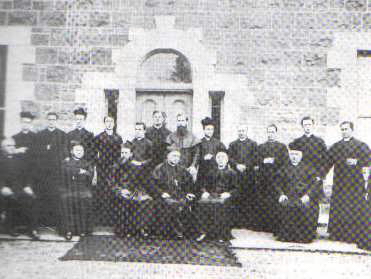
This photograph of Bishop Moran (seated, centre) and his
priests, taken probably in the early 1890's.
Seated from left - Fathers Sheehan,
O'Leary, McKay, Bishop Moran, Father Walsh and Keenan.
Standing, from left - Fathers Hunt, J .
O'Donnell, P. O'Neill, Vereker, P Murphy, J Lynch, Donnolly, J
O'Neill, Burke, P. M. Lynch, McGarth, Newport, P. O'Donnell,
Coffey.
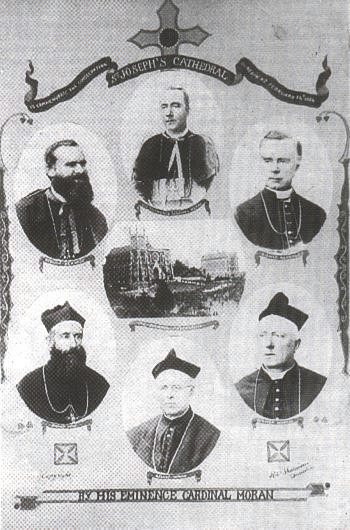
A Montage made to celebrate
Bishop Moran's consecration of St Joseph's Cathedral in 1886.
The procession into the church is shown at centre.
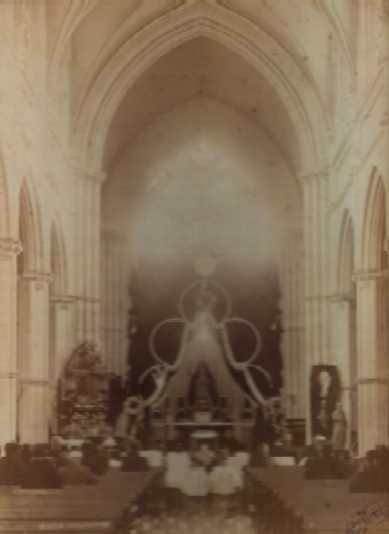
Vigil Prayers for
Bishop Moran on his death, May 1895
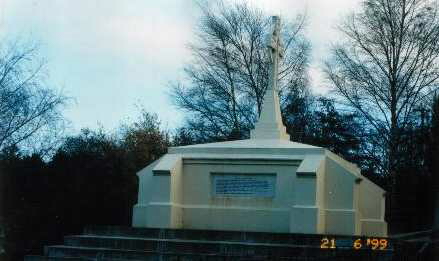
Bishops' Memorial at the
Southern Cemetery, Dunedin.

Most Rev. Patrick Moran,
D.D.
Here rests in Peace;
Patrick Moran, first Bishop of the Diocese of Dunedin. Born in
County Wicklow, 1823, he studied at Maynooth College and was
ordained priest 1847. In 1856 he was consecrated Bishop of
Dardania in South Africa. Bishop Moran was transferred in 1869 to
the new diocese of Dunedin. For twenty-six years as a watchful
pastor and able administrator he wisely governed this diocese. He
was a vigerous and eloquent defender of the Faith and Catholic
Education. He founded the N.Z. Tablet in 1873 for this specific
purpose.
He sowed the mustard seed which in his lifetime became a great
tree.
He was indeed the pride and glory of the Church in this diocese
and in New Zealand.
Bishop Moran died in Dunedin 22 May 1895 aged 72.
See: life of Bishop Patrick Moran for more information

CATHOLIC BISHOPS OF THE
DUNEDIN DIOCESE BURIED ELSEWHERE
Most Reverend Michael
Verdon, D.D., born Liverpool 1838, ordained priest Dublin 1861,
consecrated second Bishop of Dunedin 3 May 1896 in St Joseph's
Cathedral. Dounder of Holy Cross College, Mosgiel. Died
Wellington 22 November 1918. In March 1963 his remains were
transferred to Holy Cross College, and buried there in the chapel
erected to his memory.
Most Reverend Hugh John
O'Neill D.D. J.C.D, consecrated Titular Bishop of Bareta and
Co-adjutor Bishop to Bishop James Whyte, Bishop of Dunedin, 25
March 1943 in St Joseph's Cathedral. Born Dunedin 1898, ordained
priest 1921. In 1949 due to ill health resigned. Died Dunedin 27
December 1955, and is buried Andersons Bay Cemetery.
Most Reverend John
Patrick Kavanagh D.D. J.C.D., born Hawera, studied Holy Cross
College and Rome. A priest of the Wellington Archdiocese, he was
consecrated Titular Bishop of Algiza, Apostolic Administrator and
Co-adjutor Bishop to Bishop James Whyte with the right of
succession, in Wellington, 30 November 1949. Succeeded to the see
of Dunedin as fourth Bishop 26 December 1957. Died 10 July 1985
and is buried Andersons Bay Cemetery.

After the Burial of
Bishop Patrick Moran 27 May 1895 the Catholic community of the
Dunedin Diocese and elsewhere, generously contributed to the
erection of a fitting mounment over his grave. The Memorial which
included a mortuary chapel, was designed in Gothic architecture
by F. W. Petre and constructed by Mr D. Woods. This Memorial was
completed in 1896.
The height of the edifice
from the steps to the top of the cross was 16 metres. The ceiling
of the chapel was finished with a groined roof of Oamaru stone
and ornamentation similar to the interior architecture of St
Joseph's Cathedral. A vault 2.4 metres so are constructed beneath
floor level.
In November 1918, the
Most Reverend Michael Verdon, second Bishop of Dunedin, was
buried in the vault. On 5 March 1963 his remain was transferred
to the Bishop Verdon Memorial Chapel, Holy Cross College,
Mosgiel. Bishop Verdon was the founder of Holy Cross College.
The Third Bishop of
Dunedin, the Most Reverend James Whyte, died 26 December 1957,
lies buried in this vault.
Due to deteriorating
stone work and crumbling Oamaru stone, the original Memorial was
remodelled in October 1985. Surmounted now, by a very prominent
celtic cross, the Memorial fittingly commemorates
the burial place of Bishop Patrick Moran and Bishop James Whyte.

This Memorial was
re-dedicated on the occasion of the Centennial of the opening of
St Joseph's Cathedral 14 February, 1986, by the Most Reverend
Antonio Magnoni D.D. Apostolic Pro-Nuncio to New Zealand and
Fiji.
Go to top
The
Most Reverend Jean Baptiste Francois Pompallier DD
1801-1871
New
Zealand's first Bishop and Oceania 1838 -1868
See:
Pompallier
Go to top
| Home | Author |
Bishops | Building |
Choir | General |
History |
Parish | Restoration | the
original plans |




















